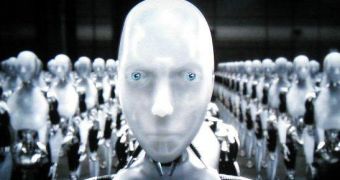Robots have been part of human imagination for longer than you think. Though modern science-fiction literary genre has made them so famous, that they've become universal brands, like "Robocop", "Terminator", "Data", "R2-D2" or "iRobot", they have been present in mythology long before.
The idea of artificial people dates at least as far back as the ancient legend of Cadmus, who sowed dragon teeth that turned into soldiers, and the myth of Pygmalion, whose statue of Galatea came to life. In Greek mythology, the deformed god of metalwork (Vulcan or Hephaestus) created mechanical servants, ranging from intelligent, golden handmaidens to more utilitarian three-legged tables that could move about under their own power.
Medieval Persian alchemist Jabir ibn Hayyan, inventor of many basic processes still used in chemistry today, included recipes for creating artificial snakes, scorpions, and humans in his coded Book of Stones. Jewish legend tells of the Golem, a clay creature animated by Kabbalistic magic. Similarly, in the Younger Edda, Norse mythology tells of a clay giant, M?kkurk?lfi or Mistcalf, constructed to aid the troll Hrungnir in a duel with Thor, the God of Thunder.
Humanoid robots are about to become reality sooner than you think, and as you would expect, they will feature superhuman characteristics like, heightened senses, physical strength and computational abilities.
One such robot, created by University of Tokyo professor Yasuo Kuniyoshi and his team of engineers, has been able to pick up and lift a 145-pound (65 kg) human dummy from a bed.
So, it's not Superman, you'd say...
Actually, the robot itself weighs just 154 pounds (70 kg), so it's like an average man picking up and lifting a black bear almost his own size. You try doing this at home.
So it's got big engines, right? Wrong!
The android robot was able to perform this without large motors due to an interesting advance in sensor technology (it has more than 1800 embedded sensors) and software that can interpret the data. "Large motors are not safe for use in household robots," explains Kuniyoshi. "Only a small amount of power is applied at each of this robot's joints, but it can successfully move heavy objects by using the tactile sensors to regulate how it lifts and carries things."
To pick up a person-sized doll from a bed (a task you might assign to a robot nurse, or a professional wrestler), it slid its arms under the doll, lifted and backed away.
The impressive feat is the fact the most advanced robot nurse so far has only been able to lift a third of its own weight.
The applications could be those seen in the "iRobot" movie, as future robots could take over some human professions, like low tech construction workers, medical nurses, or, why not, professional wrestlers.

 14 DAY TRIAL //
14 DAY TRIAL //